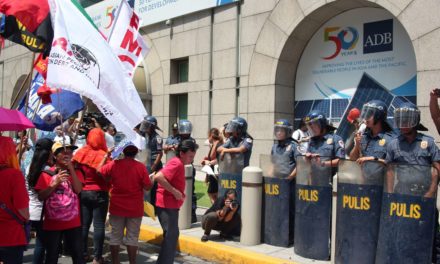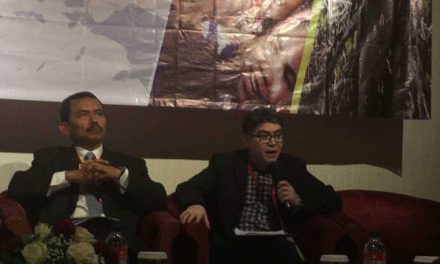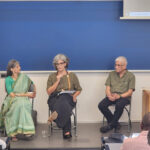(Revised version of a presentation at the Hemispheric and Global Assembly against the FTAA and the WTO held in Mexico City on May 12-13, 2003. A brief version was also delivered at the Transnational Institute Fellows Meeting in Amsterdam on May 16, 2003, and at the Jakarta International Peace Conference on May 18-21, 2003.)
Hi. This update is in two parts. The first consists of observations on recent developments in the World Trade Organizations negotiations leading up to Cancun, most of which are based on data generously shared by my colleague Aileen Kwa, Focus on the Global South’s point person in Geneva. The second part sketches the global context against which to place the developments at the WTO.
I. Recent Developments in the WTO
1. Perhaps the best way to characterize recent developments in Geneva is that the negotiations are practically at a stalemate.
– This stalemate is perhaps exemplified in the polarized situation in the agricultural negotiations. The Harbinson draft (prepared by Agricultural Negotiations Chairman Stuart Harbinson) is an orphan. The US and the Cairns Group consider its proposed tariff reductions too shallow while the European Union and Japan see them as to deep. The developing countries are concerned that the draft requires very substantial tariff cuts from them. They are also demanding a broadening of Harbinson’s proposed "strategic products" concept, which reserves a few "strategic products" for shallower tariff cuts. One thing that must be noted is that the EU and the US, in pushing for negotiating advantage, have split the ranks of the developing world. The countries in the Cairns Group, like Brazil, Uruguay, and Thailand, are siding with the US against the EU and Japan. The EU has hit back by gaining the support of India and many other developing countries for a counterproposal for agricultural liberalization that would replicate the allegedly more flexible liberalization formula of the Uruguay Round. The long and short of it is that it is very unlikely that there will be agreement on the modalities of negotiation before Cancun.
– In the Trade-Related Intellectual Property Rights (TRIPs) and public health area, there has been no give on the part of the US. It continues to maintain its position that only in the case of drugs for three diseases-HIV-Aids, malaria, and tuberculosis-should patent rights be loosened. Since this has been rejected by developing countries, the US is now talking not about loosening patent rights for public health problems but for "public health crises." American negotiators have reportedly told developing country negotiators that they can’t change their positions, and if they want any movement in the negotiations, they should talk directly to the pharmaceutical giants. Another disturbing occurrence is that the Director General, Dr Supachai himself is spreading the blame for the stalemate from the US to Brazil and India, whose manufacturers, he alleges, will be the ones that will principally benefit from looser patent rights.
– On the new issues-investment, competition policy, government procurement, and trade facilitation-the EU is now trying to delink the decision to commence negotiations on these issues from movement on the part of the EU to liberalize agriculture. They are telling the developing countries that liberalization in these issues is for their own good. To bring about some movement, the US has reportedly proposed to "unbundle" the four areas so that negotiations could proceed on them separately. The EU has publicly agreed with the US, but its preference is still to take the four areas together. The EU is also side-stepping developing countries’ concerns about substantive modalities, preferring to narrow down the negotiations on modalities to be agreed on in Cancun to procedural modalities – how many meetings should be held, etc. This has been criticized by developing countries as attempting to elicit from them a blank cheque to start negotiations without first agreeing on the substance of these negotiations.
– In two negotiating areas of great interest to developing countries, there has been absolutely no movement. These are the issues of Special and Differential Treatment and Implementation. On the latter, it might be of interest that when we met with him in Bangkok at few weeks ago, Pascal Lamy, Trade Commissioner of the EU, placed the blame squarely on the developing countries, whom he accused of not being able to agree to what were the two or three top priorities regarding implementation that needed to be tackled.
2. What does all this add up to? What does it mean for the Cancun Ministerial? We posed the question to Pascal Lamy a few weeks ago. Interestingly, his answer was to sidestep the question and simply say that if one views the process from the Doha Ministerial’s mandate for the negotiations to end by 2004, then things don’t look so bad, since "in some areas, negotiations are 2/3rds of the away through, in some halfway through, in others a third through, in TRIPs 98 per cent through."
Now, the role of ministerials is to carry out negotiations in several areas simultaneously in order to bring about a comprehensive settlement. Since member countries cannot even agree on the modalities of negotiations in so many key areas, the WTO faces a great problem of what they will do in Cancun. Perhaps this is the reason why key WTO officials are now talking about coming up not with a declaration announcing agreements on issues being negotiated, but a "communiqu?" serving as a "progress report" on the ongoing negotiations, drawing upon short reports made by the various negotiating groups on the work they have undertaken since Doha.
3. The hopes for a Doha-type outcome in Cancun have been further doused by the recent worsening of trade ties between the United States and Europe. The EU has threatened to impose sanctions on the US by the end of 2003 for tax breaks for exporters that a WTO judicial panel has found to be in violation of WTO rules. In what has been perceived as a retaliatory move, the US said it will file a case with the WTO against the EU’s de facto moratorium against genetically modified foods. Taken in the context of already existing trade conflicts as well as the bitter conflict between the US and France and Germany over the US intervention in Iraq, these recent moves do not bode well for both parties arriving at consensus positions on negotiating modalities in agriculture and other trade issues before Cancun. It must be remembered that it was not only the revolt of the developing countries at the Seattle Convention Center and the mass mobilizations in the streets that brought down the third ministerial in Seattle in 1999 but also unresolved conflicts between the US and EU on agriculture, the environment, and labor standards.
US Trade Representative Robert Zoellick and EU Trade Commissioner Pascal Lamy, who are close personal friends, are said to be moving to bridge the Washington-Brussels gap before Cancun, but the contextual conditions are more difficult now than before the Doha Ministerial in November 2001, when the US and EU shared a common position on combating terrorism and intervening in Afghanistan and Washington had not yet imposed a 40 per cent protecting tariff on steel imports and passed its $100 billion subsidies for American farmers. Nevertheless, it is important not to underestimate the capacity of Zoellick and Lamy to engineer a US-EU concordat as they did in the leadup to Doha.
II. The Global and Conjunctural Context of the WTO Negotiations
The context for understanding the stalemate at the WTO is the crisis of the globalist project and the emergence of unilateralism as the main characteristic of US foreign policy.
1. First of all some notes on the character and development of the globalist project.
– Globalization is the accelerated integration of capital, production, and markets globally driven by the logic of corporate profitability;
– It is a process accompanied by the coming to dominance of the ideology of neoliberalism, centered on "liberating the market" by institutionalizing privatization, deregulation, and trade liberalization;
– Globalization has had two phases, the first lasting from the early 19th century till the outbreak of the First World War in 1914; the second from the early 1980’s till today. The intervening period was marked by the dominance of national capitalist economies marked by a significant degree on state intervention and an international economy marked by significant restraints on trade and capital flows.
2. The apogee of the second phase of globalization was reached, in my view, with the founding of the WTO in 1995. The triumphalism marking this event was conveyed by the joint statement of the World Bank, WTO, and IMF in 1996 at the Singapore Ministerial of the WTO, where the three institutions said that the task at hand was bringing about the "coherence" of the policies of the WTO, IMF, and the World Bank to create the framework of international economic governance that would assure global prosperity.
The Economist and the rest of the establishment press toasted the WTO as the gem of capitalist global governance, setting up a "rules-based" system of world trade that both powerful and poor economies would submit themselves to. According to George Soros, the significance of the WTO lay in its being the "only global institution to which the United States was willing to subordinate its national laws."
3. In just five years, however. the globalist project, whether in its "hard" Thatcher-Reagan version or its "soft" Blair-Soros version (globalization with "safety nets") was in very serious trouble. There were three key moments to this crisis:
– First was the Asian financial crisis of 1997. This revealed that one of the tenets of globalization, the liberalization of capital account, could be profoundly destabilizing. It was main factor in the collapse of East Asian economies, with 22 million people in Indonesia and one million in Thailand falling below the poverty line in just a few months.
The Asian financial crisis was the Stalingrad of the IMF, the prime global agent of liberalized capital flows, bringing about a review of its record in Africa and Latin America, which showed that the program of structural adjustment that it had promoted alongside the World Bank had failed almost universally, institutionalizing instead stagnation, greater poverty, and greater inequality.
Along with economic crisis, the Asian financial crisis spawned a massive crisis of legitimacy and credibility of the globalist project, resulting in the defection from neoliberalism of several of its key intellectuals: Jeffresy Sachs, Jagdish Bhagwati, Joseph Stiglitz, and George Soros.
– The second moment of the crisis was the collapse of the third Ministerial of the WTO in Dec. 1999. This was due to the fusion of three volative elements into a deadly explosion: the revolt of developing countries at Seattle Convention Center, the massive mobilization of 50,000 people in the streets, and unresolved trade conflicts between the EU and the US, particularly in agriculture.
– The third moment was the collapse of the stock market and the end of the Clinton boom in March 2001. This was essentially the onset of a crisis of overproduction, the main manifestation of which was massive overcapacity. Prior to the crash, corporate profits in the US had not grown since 1997. This was related to overcapacity in the industrial sector, the most glaring manifestation of which was in the leading telecommunications sector, where only 2.5 per cent of installed capacity globally was being used. The stagnation of the real economy led to capital being shifted to the financial sector, resulting in the dizzying rise in share values. But since profitability in financial sector cannot deviate too far from profitability of real economy, a collapse of stock values was inevitable, and this occurred in March 2001, leading to the prolonged stagnation and recession that we are seeing today.
The current crisis is not simply the downside of the normal business cycle. It is the downside of the so-called Kondratieff Wave (named after the economist Nikolai Kondratieff). Kondratieff observed that capitalism progresses via 50-60 year "long waves" marked on the upside by the exploitation of new technologies and on the downside by the exhaustion of new technologies, leading to a prolonged period of stagnation before the next upswing. We are now on the trough of a wave the crest of which occurred around the late sixties and seventies.
4. The crisis of globalization, neoliberalism, and overproduction provides the context for understanding the economic policies of the Bush administration, notably its unilateralist thrust. The globalist corporate project expressed the common interest of the global capitalist elites in expanding the world economy and their fundamental dependence on one another. However, globalization did not eliminate competition among the national elites. In fact, the ruling elites of US and Europe had factions that were more nationalist in character as well as more tied for their survival and prosperity to the state, such as the military-industrial complex in the US. Indeed, since the eighties there has been a sharp struggle between the more globalist fraction of ruling elite stressing common interest of global capitalist class in a growing world economy and the more nationalist, hegemonist faction that wanted to ensure the supremacy of US corporate interests.
As Robert Brenner has pointed out, the policies of Bill Clinton and his Treasury Secretary Robert Rubin put prime emphasis on the expansion of the world economy as the basis of the prosperity of the global capitalist class. For instance, in the mid-1990’s, they pushed a strong dollar policy meant to stimulate the recovery of the Japanese and German economies, so they could serve as markets for US goods and services. The earlier more nationalist Reagan administration, on the other hand, had employed a weak dollar policy to regain competitiveness for the US economy at the expense of the Japanese and German economies. With the George W. Bush administration, we are back to economic policies, including a weak dollar policy, that are meant to revive the US economy at the expense of the other center economies and push primarily the interests of the US corporate elite instead of that of global capitalist class under conditions of a global downturn.
5. The Bush administration has supplanted the globalist political economy of the Clinton period with a unilateralist, nationalist political economy that intends to shore up the global dominance of the US corporate elite economically that parallels the aggressive military policy that is meant to ensure the military supremacy of the United States.
I would just like to point out some of the distinguishing features of this approach:
– Bush’s political economy is very wary of a process of globalization that is not managed by a US state that ensures that the process does not diffuse the economic power of the US. Allowing the market solely to drive globalization could result in key US corporations becoming the victims of globalization and thus compromising US economic interests. Thus, despite the free market rhetoric, we have a group that is very protectionist when it comes to trade, investment, and the management of government contracts. It seems that the motto of the Bushites is protectionism for the US and free trade for the rest of us.
– It is wary of multilateralism as a way of global economic governance since while multilateralism may promote the interests of the global capitalist class in general, it may, in many instances, contradict particular US corporate interests. The Bush people’s growing ambivalence towards the WTO stems from the fact that the US has lost a number of rulings there, rulings that may hurt US capital but serve the interests of global capitalism as a whole.
– For the Bush people, strategic power is the ultimate modality of power. Economic power is a means to achieve strategic power. This is related to the fact that under Bush, the dominant faction of the ruling elite is the military-industrial establishment that won the Cold War. The conflict between globalists and unilateralists or nationalists along this axis is shown in the approach toward China. The globalist approach put the emphasis on engagement with China, seeing its importance primarily as an investment area and market for US capital. The nationalists, on the other hand, see China mainly as a strategic enemy, and they would rather contain it rather than assist its growth.
6. So among the key components of Washington’s unilateralist economic strategy are:
– Control over oil, a move strategically directed not only against the EU but also against oil-poor China;
– Aggressive protectionism in trade and investment matters;
– Aggressive manipulation of the dollar’s value to stick the costs of economic crisis on rivals among the center economies and regain competitiveness for the US economy.
– Aggressive manipulation of multilateral agencies to push the interests of US capital-something we see not only in the WTO but also in the International Monetary Fund, where the US Treasury recently torpedoed the IMF management’s proposal for a Sovereign Debt Restructuring Mechanism to enable developing countries to restructure their debt while giving them a measure of protection from creditors. Already a very weak mechanism, the SDRM was vetoed by US Treasury in the interest of US banks.
7. The great advantage of multilateralism as a system of global political and economic governance was that it dispersed the defense of the system to many allies and created a degree of legitimacy and consensus among the masses that did not benefit from it. The great problem for unilateralism is overextension, or a mismatch between the goals of the United States and the resources needed to accomplish these goals.
A key base for successful imperial management is an expanding national and global economy. That will not be here for a long time. Moreover, resources include not only economic and political resources but political and ideological ones as well. For without legitimacy-without what Gramsci called "the consensus" of the dominated that a system of rule is just-imperial management cannot be stable.
Faced with a similar problem of securing the long-term stability of its rule, the ancient Romans came up with the solution of extending Roman citizenship to ruling groups and non-slave peoples throughout the empire, creating what was till then the most farreaching case of collective mass loyalty ever achieved till then and prolonged the empire for 700 years. The US unilateralists have no such "moral element" to accompany their military domination.
8. Overextension is relative, that is, it is to a great degree a function of resistance. An overextended power may, in fact, be in a worse condition even with a significant increase in its military power if resistance to its power increases by an even greater degree. Among the key indicators of overextension are the following:
– Washington’s inability to create a new political order in Iraq that would serve as a secure foundation for colonial rule;
– its failure to consolidate a pro-US regime in Afghanistan outside of Kabul;
– the inability of a key ally, Israel, to quell, even with Washington’s unrestricted support, the Palestinian people’s uprising;
– the inflaming of Arab and Muslim sentiment in the Middle East, South Asia, and Southeast Asia, resulting in massive ideological gains for Islamic fundamentalists-which was what Osama bin Laden had been hoping for in the first place;
– the collapse of the Cold War Atlantic Alliance and the emergence of a new countervailing alliance, with Germany and France at the center of it;
– the forging of a powerful global civil society movement against US unilateralism, militarism, and economic hegemony, the most recent significant expression is the global anti-war movement;
– the coming to power of anti-neoliberal, anti-US movements in Washington’s own backyard-Brazil, Venezuela, and Ecuador-as the Bush administration is preoccupied with the Middle East;
– an increasingly negative impact of militarism on the US economy, as military spending becomes dependent on deficit spending, and deficit spending become more and more dependent on financing from foreign sources, creating more stresses and strains within an economy that is already in the throes of stagnation.
We have, in short, entered a historical maelstrom marked by prolonged economic crisis, the spread of global resistance, the reappearance of the balance of power among center states, and the reemergence of acute inter-imperialist contradictions. We must have a healthy respect for US power, but neither must we overestimate it. The signs are there that the US is seriously overextended and what appear to be manifestations of strength might in fact signal weakness strategically.
In conclusion, let me make important clarification regarding the implications of the foregoing analysis to our to our task in the run-up to the WTO Ministerial in Cancun. They should not be mistaken as leading to a strategy of saving multilateralism and siding with the competitors of the US to shore up the IMF, World Bank, and the WTO. Neither US hegemony institutionalized in multilateral institutions nor US hegemony exercised unilaterally has brought about anything good for the poor and oppressed countries. Both have spelled trouble for us. On the contrary, the task at hand is to take advantage of the sharpening competition among the US and the other big economic powers to disempower, if not dismantle, the WTO, World Bank, and the IMF. The task at hand is to redouble our collective efforts to derail the Cancun Ministerial.
From this vantage point, let us beware of the proposal being floated by the WTO leadership to form an NGO Advisory Committee for the WTO. This idea is nothing more than a Trojan Horse planted in our midst to split our ranks and shore up an institution of the global capitalist elite that is in the grip of an irreversible crisis of legitimacy.
I thank you.





![[IN PHOTOS] In Defense of Human Rights and Dignity Movement (iDEFEND) Mobilization on the fourth State of the Nation Address (SONA) of Ferdinand Marcos, Jr.](https://focusweb.org/wp-content/uploads/2025/07/1-150x150.jpg)



